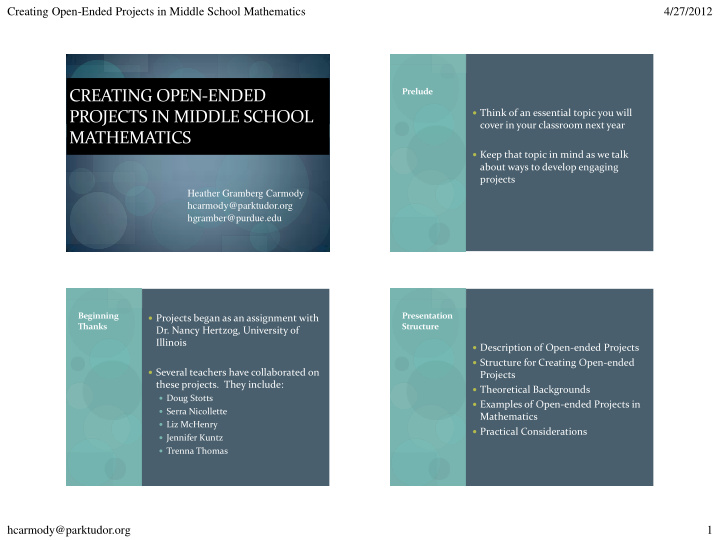



Creating Open-Ended Projects in Middle School Mathematics 4/27/2012 Prelude CREATING OPEN-ENDED Think of an essential topic you will PROJECTS IN MIDDLE SCHOOL cover in your classroom next year MATHEMATICS Keep that topic in mind as we talk about ways to develop engaging projects Heather Gramberg Carmody hcarmody@parktudor.org hgramber@purdue.edu Beginning Presentation Projects began as an assignment with Thanks Structure Dr. Nancy Hertzog, University of Illinois Description of Open-ended Projects Structure for Creating Open-ended Several teachers have collaborated on Projects these projects. They include: Theoretical Backgrounds Doug Stotts Examples of Open-ended Projects in Serra Nicollette Mathematics Liz McHenry Practical Considerations Jennifer Kuntz Trenna Thomas hcarmody@parktudor.org 1
Creating Open-Ended Projects in Middle School Mathematics 4/27/2012 Reference for Related Article What are Open-ended Projects? Carmody, H. G. (2010). Water bottle designs and measures. Ill-structured assignments that require creativity Mathematics Teaching in the Middle School, 16 (5), 272-277. to finish A form of learning activities and authentic assessment A way to build differentiation into a general assignment What is the purpose of an Open-ended Where have they been used? Project? Application of academic concepts to real life Seventh grade classrooms situations Large public schools with ≈30 students per class Small private school with ≈15 students per class Movement beyond basic skills and to explore Wide range of abilities meaningful applications Culturally and linguistically diverse settings Other settings (rural, urban and suburban) by Encourage independence and autonomy other teachers Require students to reflect upon and refine their work hcarmody@parktudor.org 2
Creating Open-Ended Projects in Middle School Mathematics 4/27/2012 How do they fit with school curriculum? Structure for Creating Designed to complement daily lessons OMPs Seven Design Components Content Components Students work in class and at home Supportive Instructional Components Questions to Develop New OMPs Projects typically take 2 to 3 weeks to complete Content Components Supportive Instructional Components Extensive mathematical computation 1. 5. Project proposal 2. Algebraic notation 6. Peer collaboration 3. Written expression 7. Reflection and self-evaluation 4. Visual or graphic representation (Carmody, 2010) (Carmody, 2010) hcarmody@parktudor.org 3
Creating Open-Ended Projects in Middle School Mathematics 4/27/2012 Questions to Create an OMP Questions to Create an OMP What choices can I offer in terms of content or What topic is essential to the curriculum? product? What resources will students need for the project? What are some meaningful and real world applications of this topic? What amount of time will students need to produce quality work? How can I structure a timeline that allows for creativity and rigor? What applications are appropriate for students of this age and level of mastery? Are there adequate opportunities for differentiation to accommodate various student needs? How can I include the different components? Does this project encourage a deeper understanding of mathematics than students would otherwise have? Recommendations for Students (gifted and beyond) Justification from Depth of application (Hirsch and Weinhold, 1999) Educational Recommendations for Students Research Recommendations for Classrooms Opportunities to reflect upon and refine their Recommendations for Teachers work (Koshy, 2001) Recommendations for Assessment Opportunity to discuss their thinking with peers and adults (Hirsch and Weinhold, 1999) Differentiation in terms of content, process and product (VanTassel-Baska, & Stambaugh, 2006) hcarmody@parktudor.org 4
Creating Open-Ended Projects in Middle School Mathematics 4/27/2012 Recommendations for the Classroom Recommendations for Teachers Provide time to let ideas develop and form “Challenge students with rich problems that (Hadamard, 1945) encourage deep exploration” ( Warshauer et al., 2010) Provide the chance for “responsible risk taking” (Costa, 2001) Provide opportunities to demonstrate giftedness (Koshy, 2001) Emphasize independence, and favor flexibility over structure or chaos (Wheatley, 1999) Move past “unimportant knowledge” ( Renzulli, Provide students support to move beyond the familiar 1982) into areas of challenge and creativity (Mann, 2006) Recommendations for Assessment “assessment [should] be an integral part of Rate and Ratio Project teaching” ( Zemelman, Daniels and Hyde, 1998, pg. Examples Water Bottle Project 105) Project “flops” A few warnings Assessment can have “a significant role in the learning process” (Taylor, 2009) hcarmody@parktudor.org 5
Creating Open-Ended Projects in Middle School Mathematics 4/27/2012 Rate and Ratio OMP Rate and Ratio OMP Student Materials Targeted Concepts Required Components Project Assignment Rates Researched starting Grading Rubric fact Unit Rates Seven equivalencies Ratios with at least two Proportions visualizations Dimensional Analysis Poster or PowerPoint Rate and Ratio OMP Examples Water Bottle OMP Amanda – Gasoline Consumption Targeted Concepts Required Components Volume Table with three Sean – Professional Athlete’s Salary proposals Surface Area Flat pattern or Solving for Unknown Caven – Chewing Gum prototype of favorite Quantities design Relationship between Writing to persuade 2-D patterns and 3-D others that their design objects is best hcarmody@parktudor.org 6
Creating Open-Ended Projects in Middle School Mathematics 4/27/2012 Water Bottle OMP Student Material Water Bottle OMP Examples Assignment Sheet Grid for 3 proposals Grading Rubric OMPs that Did Not Work Small Warnings Start small – a goal of 4 Open-ended Projects per year is very reasonable Story Project Construct your grading rubric ahead of time Menu Project took a few years to refine After completing the project, ask for student opinions. My projects are always evolving. hcarmody@parktudor.org 7
Creating Open-Ended Projects in Middle School Mathematics 4/27/2012 Resources Contact Information Through NCTM resources By email request Heather Gramberg Carmody OMPs Bibliography hcarmody@parktudor.org Water Bottle OMP Components Rate and Ratio Questions to Develop Spreadsheet Or OMP Integer Game Presentation Slides Menu Transformations hgramber@purdue.edu Surveys Examples of student work hcarmody@parktudor.org 8
Recommend
More recommend